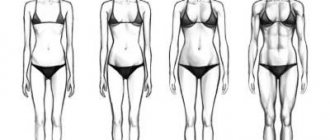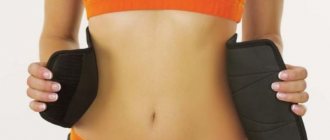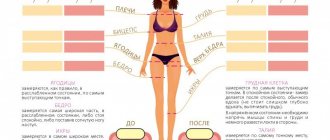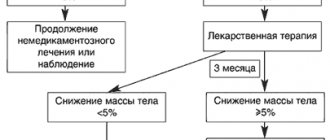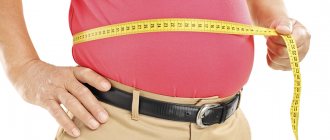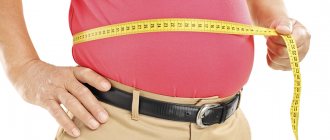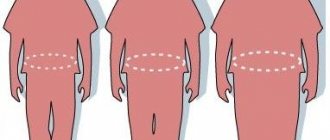The beauty of the male body largely depends not only on the relief and volume of muscles. To achieve the ideal, it is much more important to maintain the proportionality of all its parts: the volume of the chest with the pelvis, and so on. Differences in age and race of a person have proportional significance. Let's figure out what the ideal proportions of a man's body are. This will be equally useful for both professional athletes and people who strive for excellence.
Standard shoulder width for men
It is important to understand that an athletic figure and broad shoulders in men are primarily a matter of proportionality and body type (endomorph, ectomorph or mesomorph), and not muscle size. Excessively wide shoulders visually reduce a person’s height, just as the “height” of a hairstyle and the presence/absence of facial hair can make the body more powerful.
The secret is that, according to Da Vinci’s canonical proportions, the ideal width of a man’s shoulders is ¼ of his height - that is, 45 cm with a height of 180 cm. According to the same standards, the girth of the biceps should be equal to the girth of the neck and calves.
Greek statues
Interestingly, ancient Greek statues depicting gods and athletes, although they follow the rules of ideal proportions, are still made with certain violations of human anatomy - for example, tense back muscles are impossible with relaxed pecs.
Ancient sculptors improved not only the proportions of the bodies of the athletes who posed for them, but also changed reality, giving ease to uncomfortable poses and creating a composition of tense muscles that was unique in life. Apparently, the secret of the ideal is that it cannot be achieved.
Da Vinci's canonical proportions
The drawing, created by Leonardo Da Vinci and depicting the figure of a naked man in two superimposed projections, served as an illustration for a book about the life of the Roman architect Vitruvius, who was the first to describe on paper the proportions of an ideal person.
The pose with arms spread and legs brought together is inscribed in a square, and the pose with arms and legs spread out to the sides is inscribed in a circle. The center of the circle is the navel of the figure, and the center of the square is the genitals. Some explanations for the picture (1):
- the span of human arms is equal to his height
- human height is four cubits from the fingertips
- the distance from the hairline to the chin is 1/10 of its height
- the distance from the top of the head to the chin is 1/8 of its height
- the distance from the top of the head to the nipples is 1/4 of its height
- maximum shoulder width is 1/4 of its height
- arm length is 2/5 of its height
Figure proportions for artists
Beginning artists are taught how to draw a person correctly, starting with choosing the size of the head. The total height of the figure should be eight heads (see paragraph 4 of Da Vinci's rules). The next step is to fit the circle into the head (see title illustration).
The height of the head and neck should be two such circles, exactly the same as the distance from the navel to the lower border of the neck, while the maximum width of the shoulders should be three. The waist width is no more than one and a half circles, otherwise the proportions of the figure will be significantly distorted.
Figures of muscular people
One of the most important rules of proportionality for a muscular person is the ratio of shoulder circumference to waist width (see Figure 3). If we take the waist width as “a” and the shoulder circumference as “b”, then the ideal ratio would be (a+b)/a = a/b = 1.618.
Enlarged deltas, pectoral muscles, overdeveloped abs - all this can destroy fragile symmetry, making a person’s figure visually disproportionate. However, understanding these rules can change an initially unathletic figure beyond recognition.
Classic bodybuilder proportions
In the thirties of the last century, American anthropologist David P. Willoughby carried out many measurements of athletes, trying to determine the ideal muscle sizes that seem as correct as possible to the human eye. His results (3):
- Biceps size - 1.2 forearm sizes
- Forearm from chest width - 0.300
- Biceps from the circumference of each calf - 1
- Neck from chest circumference - 0.383
- Chest - 1.33 waist size
- Chest - 1.11 hip size
- Hips - 1.5 calf size
How to measure your proportions?
First, measure the circumference of your forearm at its widest point; then calculate the size of your biceps - 1.2 the size of your wrist. Compare with the measurement of each bicep and each calf. Calculate chest circumference - multiply forearm circumference by 3.33; compare with real value.
Then measure your waist (see illustration 4) and hips. According to ideal athletic proportions, the chest circumference should be 1.33 waist circumference and 1.11 hip circumference. Take these measurements once a month to track your training progress.
Creating an athletic figure is more about controlling the proportions of muscles, rather than simply increasing their volume. There is both the classical school of proportions, known since the time of ancient Greek statues, and modern measurements suitable for bodybuilders.
The ideal proportions of a male body are considered to be tall height, a V-shaped torso and compliance with certain parameters, which may differ for men of different ages. Nationality and occupation also leave some imprint on the standard of beauty. At the same time, an athletic figure, broad shoulders and chest, sculpted muscles combined with narrow hips have always attracted the attention of the fair half of humanity.
WEIGHT LOSS STORIES OF STARS!
Irina Pegova shocked everyone with her weight loss recipe: “I lost 27 kg and continue to lose weight, I just brew it at night. » Read more >>
The path to an ideal body begins with measuring it. That is, before you change anything about yourself, you need to determine which part of the body requires improvement.
For a more correct result of measurements, they should be carried out in the morning, since after waking up, that is, during the period when rested muscles are relaxed, the body’s indicators will be as accurate as possible. During the day, various loads can greatly distort the data. Only those who, for some reason, experience swelling in the morning can ignore this rule.
The main measurable places of the male body
An ordinary sewing centimeter or tape measure is quite suitable for measuring. If none of the above is at hand, a thread and a ruler will do: grab it with a thread, measure with a ruler.
Below are the basic rules to follow when taking measurements:
| Measuring area | Measuring technique |
| Neck | The head should be kept level. In this position, the transverse line of the neck is measured exactly in the middle |
| Rib cage | Three parameters are measured: in the normal state, at maximum inspiration, and at full exhalation. The centimeter should be placed on the pectoral muscles at the level of the nipples with the arms lowered along the body |
| Waist | The measurement is taken at the narrowest point - approximately where the chest and ribs end |
| Shoulder | The arm bends at the elbow, the biceps and triceps become tense; in this position measure the widest circumference |
| Forearm | The widest area of the forearm is measured |
| Hip | In a calm, standing position, measurements are taken directly under the buttocks. |
| Shin | The calf is measured at its widest point |
Body type
Ideal body proportions in Ancient Greece
Venus de Milo was considered the ideal of female beauty in Ancient Greece, and Apollo Belvedere was considered the ideal of male beauty. Ancient Greek statues depicting these and other gods were created by sculptors taking into account ideal body proportions. These proportions were carefully determined and observed by the sculptors.
Ancient Greek standards:1. The head should be 1/7 of the height, 2. Legs – 1/6, 3. Wrist – 1/10 of the person’s height. 4. The center of the body of a person located in a circle, in proportion, should be the navel.
Proportions and dimensions of the Venus de Milo: height – 164 cm, bust – 86 cm, waist – 69 cm, hips – 93 cm.
And now many consider such proportions of the female body to be ideal
Proportions and dimensions of the sculpture Spearman (sculptor Polykleitos). height -178 cm body parts in girth: lower leg - 42 cm, biceps - 38 cm, buttocks - 108 cm, chest - 119 cm, thigh - 60 cm, forearm - 33 cm, wrist - 19 cm, waist - 93 cm
The meaning of the “Vitruvian Man” is that only the ideal proportions of the human body make it possible to fit a position with arms and legs apart into a circle, and with arms and legs apart into a square. Later, this theory became widespread in fine arts and architecture.
The proportions indicated in the drawing by Leonardo Da Vinci: the span of human arms is equal to his height; the height of a person is four cubits from the fingertips; the distance from the hairline to the chin is 1/10 of his height; the distance from the crown to the chin is 1/8 of his height; the distance from the crown to the nipples is 1/ 4 of his heightmaximum shoulder width is 1/4 of his heightarm length is 2/5 of his height
Currently, calculations of the ideal proportions of a man’s body can be carried out using several popular methods - Brock’s method, McCallum’s formula or the Wilks coefficient (Wilks). John McCallum, for example, emphasizes the need for equal lengths of the legs and torso. In addition, the size of the chest, according to his formula, should be larger than the size of the pelvis (about 10 to 9).
Current standards have a direct connection with the ideals of the ancient world. This is a kind of symbiosis of an ancient image and a modern understanding of beauty. Here are the main points of an ideal figure for men:
- Slender, long neck.
- Clear trapezoid lines.
- Relief shoulder muscles.
- Cone-shaped pectoral muscles.
- Relief structure of the abdominal muscles.
- Pronounced back muscles, wide dorsal profile.
- Developed muscles of the lower extremities.
Depending on age, all body proportions will change. The fact is that every year the human body acquires certain physiological changes. Until the age of 25, body height and weight change. A man should begin exercising the muscle component no earlier than 16 years of age. Otherwise, the muscles may become stiff. You shouldn't overload them either. This can lead to the fact that in the future they will not develop and change their volume.
Modern beauty standards: basic parameters
The modern world has its own concepts and ideal body parameters. Each of us at least once in our lives thought about whether our characteristics fit these values? Below we will present to your attention the classic ideal proportions of the human body in modern fitness and bodybuilding.
People are accustomed to consider this criterion to be more important than others, although this is fundamentally wrong. However, in everyday life there is an opinion that the taller a person is, the stronger, more courageous and more dangerous he is in conflicts.
Standard growth parameters for residents of Russia and CIS countries:
- people with a height below 170 cm are considered small;
- 175-185cm is considered average and optimal height;
- People taller than 190 cm are considered tall.
It is worth noting that people of different nations and nationalities have different average indicators, and the above figures will not be considered the norm for them. If you want to grow taller, then you need to put a lot of effort into certain height-increasing workouts. You also need to know that this parameter cannot be adjusted after 25 years.
The height of each person is individual, based on this, everyone can calculate the ideal proportions of height and weight for themselves. There is a way to check this - the Quetelet index.
It is relevant for men and women aged 20 to 60 years. To determine your body proportions and find out their indicator relative to the norm, you need to solve a simple arithmetic equation. But the result may not be correct if you are a professional athlete, a pregnant woman or a young man.
Measure your height, raise it to the second power. After this, the body weight must be divided by the resulting figure. Example: 175 cm, 70 kg; 70:(1.75*1.75) = 22.8. The answer in the equation will be considered the correct body proportion index.
- the norm for males is 19.5-25.5;
- the norm for females is 19.5-24.5;
- weight deficit – up to 18.5;
- excess – 25.5-29.5;
- first degree obesity – 30-35;
- second degree – 35-40;
- third degree – 40+.
Waist
Based on the table of ideal proportions, we present the optimal waist to height ratios for men and women:
- height 150-155 cm: minimum – 55 cm, maximum – 60 cm;
- 155-160 cm: 60, 65;
- 160-170 cm: 63, 69;
- 170-180 cm: 69, 73.
To determine your waist size, measure it with a tape measure at the point where your ribs begin.
Legs
The standard leg length is considered to be 50-56% of a person’s height, depending on gender. You should do this measurement standing with your back straight. The circumference of the ankles, hips and legs should be proportional to the length of the entire body. For example, the ideal ratio of these body parts for a height of 175-180 cm is 59.38 and 21 cm.
Instructions for taking measurements
In order for the results of measuring body proportions to be as correct as possible, they should be carried out in the morning. The fact is that the body after sleep has the most accurate values. During the day he experiences stress, as a result of which the data may be far from the truth.
Measurements should be taken using an ordinary tape with sections. It will show the most correct results. If you don’t have one on hand, you can use nylon thread and a regular ruler or construction tape.
In order to track changes in the proportionality of body parts, you should keep a diary. It is best to take measurements no more than once a week.
Pay attention to your diet. It should contain as much protein as possible and a minimum of fat. Fast carbohydrates should also be avoided. They break down very quickly and do not bring any results. Try to eat more vegetables and cooked meat. This will allow you to build muscle mass as quickly as possible, and will also increase the productivity of your workouts.
1 Comment
Where is the formula by which all tabular data was calculated. For example, with a height of 186 cm, I have an arm span of 198 cm, but this looks quite organic, from this calculation regarding the forearm, my indicators will be completely different, if when you request data on Google, your article is one of the first to be displayed, then at least do it its more scientific and readable.
Ideal male figure
There are many ways to determine whether you have the ideal male figure. After all, having a strong body, ideal legs with developed muscles does not mean anything. Let's consider the basic relationships, proportions and indices of the ideal human figure.
Waist to Shoulder Ratio
The ideal ratio of shoulder width to waist in men is the main sign of a reference body.
The beauty standard is the ratio of forearm circumference to waist circumference, which should be 0.75. This indicator is the standard and is considered the most attractive for women.
If your waist-to-shoulder ratio falls short of this standard, don't worry. Indeed, in modern bodybuilding there are many training options to obtain the necessary proportions. For example, if you need to reduce the value obtained, then you need to adhere to exercise regimes that will help burn fat calories in these places. In this case, it is necessary to build up the shoulder and back muscles.
Standard waist circumference values for men of different heights:
- 165-172 cm – 76-80 cm;
- 170-183 cm – 80-83 cm;
- 180-190 cm – 83-86 cm.
Standard shoulder circumference values:
- 165-172 cm – 41-43 cm;
- 172-183 cm – 43-45 cm;
- 180-190 cm – 45-47 cm.
Bust to waist ratio
The ideal proportions of the male body are considered to be a figure similar to an inverted triangle (V). With this body type, the chest stands out and the waist is narrow.
The difference between the circumferences of the chest and waist will help determine the ideal parameters of a male figure. The standard value is considered to be 25.
According to scientists, men with such indicators have fairly good health and get sick less.
Standard waist circumference values for men of different heights:
- 165-172 cm – 76-80 cm;
- 170-183 cm – 80-83 cm;
- 180-190 cm – 83-86 cm.
Standard chest girth values:
- 165-172 cm – 115-118 cm;
- 172-183 cm – 118-123 cm;
- 180-190 cm – 123-128 cm.
Adonis Index
This method of calculating the ideal proportions of a man’s body was developed by the ancient Greeks.
The Adonis index is based on the proportions of the “golden ratio”. The method is to divide the whole into two parts, in which the ratio of the larger to the smaller will be equal to the ratio of the whole to the larger. The main values for determining the “golden ratio” in human anatomy are shoulder width, waist and overall height. Thus, the “golden ratio” (ideal human parameters) will be considered a waist-to-shoulder ratio of 1:1.618.
Classic body proportions
Each person has a different proportionality to their body.
Taking the average indicators from the table of proportions of an ideal physique, we present the canons of proportions:
With a height of 165-170 cm:
- weight – from 65 to 72 kg;
- shoulders – from 35 to 37 cm;
- neck – from 35 to 37 cm;
- chest – from 105 to 110 cm;
- waist – from 75 to 80 cm;
- thigh – from 55 to 57 cm;
- shin – from 35 to 37 cm.
With a height of 170-175 cm:
- weight – from 72 to 80 kg;
- shoulders – from 37 to 40 cm;
- neck – from 37 to 40 cm;
- chest – from 110 to 115 cm;
- waist – from 80 to 85 cm;
- thigh – from 57 to 37 cm;
- shin – from 35 to 40 cm.
With a height of 175-185 cm:
- weight – from 81 to 90 kg;
- shoulders – from 40 to 45 cm;
- neck – from 40 to 45 cm;
- chest – from 115 to 125 cm;
- waist – from 85 to 95 cm;
- thigh – from 60 to 65 cm;
- shin – from 40 to 45 cm.
Proportions according to da Vinci
The great scientist Leonardo da Vinci created his own proportions for the ideal figure of a man and woman.
According to da Vinci, the ideal proportions of a male body should correspond to the following parameters:
- height – 24 palms;
- foot length – 4 palms;
- elbow length – 6 palms;
- arm length and shoulder volume – 1.6 of total height;
- the length of one ear is 0.33 of the length of the head;
- the distance from the chin to the beginning of the hair on the forehead is 0.1 of the total height;
- the distance from the chin to the top of the head is 0.125 of the total height;
- distance from hair to eyebrows – 0.33 of the total length of the face;
- the distance from the armpits to the elbow is 0.125 from the height.
Standards in bodybuilding
Currently, the standard for the male body is professional bodybuilders. They acquired ideal body parameters after long and hard training on themselves.
Ideal proportions in bodybuilding are:
- clear trapezoid lines;
- relief muscles;
- cone-shaped pectoral muscles;
- clearly defined back muscles;
- slender neck;
- developed muscles of the lower extremities.
The concept of ideal today
If we take ancient statues, their sizes are closer to natural parameters, which is explained by the rule of the “Golden Section”, derived by the ancient scientist Pythagoras. And, based on it, perfection should be determined by the following proportions for both sexes:
- waist size should be twice the neck circumference;
- in turn, the neck is twice the circumference of the wrist;
- shoulder width should not exceed 1/4 of a person’s height;
- The size of the forearm and foot (their length) should ideally be equal.
If something doesn’t add up, it means the figure is not perfect. But seriously, since every person is unique, we shouldn't be so strict about perfection.
Important indicators of a perfect body today are: age, height and wrist circumference. Essentially, this is a measurement of the bones, which determines the light, heavy and medium type of build.
- Thin-boned type – 14.5 cm in women, 18 cm in men;
- The average constitution is 15-18 cm for women, 18-20 cm for men;
- Heavy type - 18.5-20.5 cm in women, more than 20 cm in men.
To calculate the optimal weight for a woman, you should use the formula: for a man, subtract 100 from your height in cm and multiply this number by 0.85.
Women also need to subtract 100 from their height, and then multiply the resulting figure by 0.9.
| Weight height | Neck | Biceps | Forearm | Breast | Waist | Pelvis | Hip | Shin |
| 0,34 | 35,6 | 33,3 | 27,7 | 92,5 | 69,3 | 83,3 | 50,0 | 33,3 |
| 0,36 | 36,8 | 34,5 | 28,7 | 96,3 | 72,1 | 86,6 | 51,8 | 34,5 |
| 0,39 | 38,1 | 35,8 | 30,0 | 99,8 | 74,7 | 89,7 | 53,8 | 35,8 |
| 0,42 | 39,6 | 37,1 | 31,0 | 103,4 | 76,2 | 93,0 | 55,9 | 37,1 |
| 0,44 | 40,9 | 38,4 | 32,0 | 106,9 | 80,3 | 96,3 | 57,7 | 38,4 |
| 0,47 | 42,4 | 39,9 | 33,3 | 110,5 | 82,8 | 99,6 | 59,7 | 39,9 |
| 0,50 | 43,7 | 41,1 | 34,3 | 114,3 | 85,6 | 102,9 | 61,7 | 41,1 |
| 0,53 | 45,2 | 42,4 | 35,3 | 117,9 | 88,4 | 105,9 | 63,5 | 42,4 |
| 0,57 | 46,5 | 43,9 | 36,6 | 121,9 | 91,4 | 109,7 | 65,8 | 43,9 |
| 0,60 | 47,8 | 45,2 | 37,6 | 125,5 | 94,2 | 113,0 | 67,8 | 45,2 |
Based on the tabular indicators, it should be taken into account that the coefficient of weight and height is found by dividing these two parameters. For an athlete weighing 100 kilograms and height 180 cm, it is 0.555.
| Height, cm | Weight, kg | Neck, cm | Biceps, cm | Chest, cm | Waist, cm | Hip, cm | Shin, cm |
| 165 | 65,0 | 35,0 | 35,0 | 105 | 75 | 55,0 | 35 |
| 166 | 66,5 | 35,5 | 35,5 | 106 | 76 | 55,5 | 35,5 |
| 167 | 68,0 | 36,0 | 36,0 | 107 | 77 | 56,0 | 36,0 |
| 168 | 69,5 | 36,5 | 36,5 | 108 | 78 | 56,5 | 36,5 |
| 169 | 71,0 | 37,0 | 37,0 | 109 | 79 | 57,0 | 37,0 |
| 170 | 72,5 | 37,5 | 37,5 | 110 | 80 | 57,5 | 37,5 |
| 171 | 74,0 | 38,0 | 38,0 | 111 | 81 | 58,0 | 38,0 |
| 172 | 75,5 | 38,5 | 38,5 | 112 | 82 | 58,5 | 38,5 |
| 173 | 77,0 | 39,0 | 39,0 | 113 | 83 | 59,0 | 39,0 |
| 174 | 78,5 | 39,5 | 39,5 | 114 | 84 | 59,5 | 39,5 |
| 175 | 80,0 | 40,0 | 40,0 | 115 | 85 | 60,0 | 40,0 |
| 176 | 81,5 | 40,5 | 40,5 | 116 | 86 | 60,5 | 40,5 |
| 177 | 83,0 | 41,0 | 41,0 | 117 | 87 | 61,0 | 41,0 |
| 178 | 84,5 | 41,5 | 41,5 | 118 | 88 | 61,5 | 41,5 |
| 179 | 86,0 | 42,0 | 42,0 | 119 | 89 | 62,0 | 42,0 |
| 180 | 87,5 | 42,5 | 42,5 | 120 | 90 | 62,5 | 42,5 |
| 181 | 89,0 | 43,0 | 43,0 | 121 | 91 | 63,0 | 43,0 |
| 182 | 90,5 | 43,5 | 43,5 | 122 | 92 | 63,5 | 43,5 |
| 183 | 92,0 | 44,0 | 44,0 | 123 | 93 | 64,0 | 44,0 |
| 184 | 93,5 | 44,5 | 44,5 | 124 | 94 | 64,5 | 44,5 |
| 185 | 95,0 | 45,0 | 45,0 | 125 | 95 | 65,0 | 45,0 |
To check how important proportions are for professional athletes, you can compare the body measurements of the best bodybuilders against tabular data that demonstrates ideal girth sizes.
Knowing exactly what proportions in bodybuilding are taken as ideal, each athlete has a chance to measure and compare their own parameters with them.
Body proportionality, as has already become clear, is crucial for a professional bodybuilder. Whether an amateur should strive for such an ideal is a separate topic that requires more detailed consideration.
Professionals bring their body proportions to ideal levels through the use of pharmacological drugs. In amateur bodybuilding, everything depends on genetics. Small shoulders and a narrow back cannot be greatly expanded without serious sports pharmacology. This also applies to the chest. It will not become much larger if there is no such predisposition.
If measurements show that the proportions do not correspond to ideal ones, you should not be upset. Achieving perfection is necessary only for those who strive to perform and win competitions. For amateur bodybuilding, perseverance and training are important, allowing you to improve your natural abilities in order to feel great on the beach or in the pool, and increase self-esteem.
Ideal female figure
Every girl wants to be beautiful and puts a lot of effort into this. In the world of fitness and fashion, there are ideal proportions of the female body (legs, waist, chest, hips, etc.).
Main female body types
There are five types of female body types:
Triangle. The characteristic signs of this body in women are:
- voluminous hips;
- narrow shoulders;
- small waist size;
- The upper part of the body is longer than the lower.
- hip volume is less than shoulder volume;
- the upper body is shorter than the lower;
- the waist is not expressed.
- approximately equal width of body parts;
- the waist is not expressed;
- protruding belly;
- with low weight, strong muscle relief.
Eight. Classic type, which is in demand in the modeling business (body proportions 90/60/90):
- the lower part of the body is proportional to the upper;
- slim waist;
- waist to hip ratio is 0.7.
- pronounced breasts;
- Thin legs;
- small shoulder volume;
- voluminous waist
Classic proportions for women
Ideal body proportions for women were developed by D. A. Konokhin.
According to his calculations, per centimeter of total body length there are:
- neck – 0.17-0.21 cm;
- shoulder – 0.17-0.21 cm;
- hips – 0.31-0.35 cm;
- chest – 0.45-0.5 cm;
- pelvis – 0.55-0.65 cm;
- waist – 0.36-0.41 cm.
To understand how well your body fits the ideal shape, multiply your height (cm) by the above values from the table. Then measure the circumference of the body parts you are interested in. The result will show how close or far you are from the standard.
Refined waist
Every woman's body type is different and unique. The ideal parameters of women differ significantly from the male figure.
Below are the waist width standards for girls of different heights:
- height 150-155 cm – waist 57-58 cm;
- 155-160 cm – 58-60 cm;
- 160-165 cm – 60-62 cm;
- 165-170 cm – 60-64 cm;
- 170-175 cm – 64-66 cm;
- 175-180 cm – 66-68 cm.
Permissible deviations can reach five centimeters. The measurements will be accurate if there is no excess fat around your waist.
Hip to chest ratio
In the world of fashion and modeling, the most important parameters for women are hips, chest and waist.
The circumference of the forearm should be equal to the circumference of the hips. First of all, it looks aesthetically beautiful. If your body type is different, there is no need to be upset. In fitness, there are many specific workouts to get your hips and chest into the ideal ratio.
Growth parameters
There is no concept of ideal height for a woman. After all, each person is individual in himself. Also, average height may differ in different countries and peoples.
To determine whether you have an ideal ratio of height to other parts of the body, you need to resort to the “golden ratio” method (Adonis index), which we wrote about earlier in this article. For example, shoulder width should be 1/7 of height.
Leg length
The ideal proportions of a girl’s legs depend on whether she has a thin or wide bone. Here is an example of the ideal proportions of legs to body:
- if a girl has a wide bone, then her legs should be about 1.5-4.5 cm longer than half the length of her full height;
- if the bone is medium, then their length should be 4-7 cm longer;
- thin – 50% height + 6.5-10 cm.
Realistic goals
Joe Roak suggests following this rule: “To determine arm potential, multiply your wrist circumference in inches by 2.3.”
For example, if the wrist size is 7 inches (17.78 cm), then multiplying by 2.3 we get 16 inches (about 40 cm). You say, who would want to have 16-inch arms? Believe me, skinny 16-inch arms look bigger than they actually are.
Among the Gainesville athletes, only one had arms larger than 16 inches (Craig Holaday). Moreover, you must reach 16 inches first before moving on. If you already have an arm at a full 16 inches, then your goal should be 17 inches, and if it is 17, then your goal should be 18 inches. Be realistic and move towards the final result gradually.
How to achieve ideal parameters
In order to achieve ideal parameters, you should adhere to a certain training regimen, lead an extremely healthy lifestyle, and systematically measure your chest and hip girth.
It is in these parts of the body that fat deposits accumulate the most.
Regular training
To achieve the desired result faster, you need to train regularly. On the Internet there are many tables and methods for men and women to improve their body and keep it in good shape. Here are the basic rules that you must adhere to while playing sports:
- Don't overload yourself. Excessive overwork will not give the desired results, but will only harm your body.
- Don't do intense workouts every day. Daily vigorous exercise will not bear fruit, since muscle mass increases during rest.
- To increase the volume of the chest, the simplest ways are push-ups and pull-ups on the horizontal bar.
- To tighten your gluteal muscles, do more running and squats in the morning.
Know that regular exercise will help you not only gain muscle mass or burn calories, but also strengthen your health, immunity, and reduce the risk of developing most diseases.
Proper nutrition
An important criterion for getting an ideal body is proper nutrition.
We will give you some useful tips:
- Eat four times a day, but in small portions. This will reduce the risk of fat deposits and improve digestion.
- Don't eat fatty and fried foods.
- Eat foods that are rich in protein. It is what promotes faster muscle growth after training.
- To maintain a waistline in women, eat more “green” and “red” foods.
- Monitor your daily calorie intake.
- Don't drink soda and try to consume minimal amounts of sugar.
Bodymaster.ru recommends Fitness Trainers:
This kind of heavy, but infrequent training with a few core exercises specifically for athletes with this type of constitution was created back in the 1930s by Joseph Curtis Hise, a pioneer in strength training. Hise is considered the creator of the "breathing" squat, using heavy weights and high reps to achieve rapid gains in strength and size.
So, instead of lifting weights 5-6 times a week, doing 10-15 sets for each body part, which, according to most bodybuilders, is considered the only way to gain muscle in the gym, you can start training with a squat breathing program with 20 repetitions of Hayes.
Recommendations from experts
To achieve the ideal standards of a male or female body, here are some recommendations from experts:
- Don't believe false promises. In order to get the desired result, you need to train a lot.
- Don't use steroids, etc. All drugs of this type give a temporary effect. After stopping the course, your skin may sag.
- Decide what exactly you want to improve in your body. This way you can achieve the desired result faster.
- In addition to training, follow a sports diet regimen.
- Join a gym. Working out with a trainer will give you results much faster than doing it on your own.
- Before any workout you need to warm up. If you don't do this, there is a high chance that you may pull one or more muscle groups.

